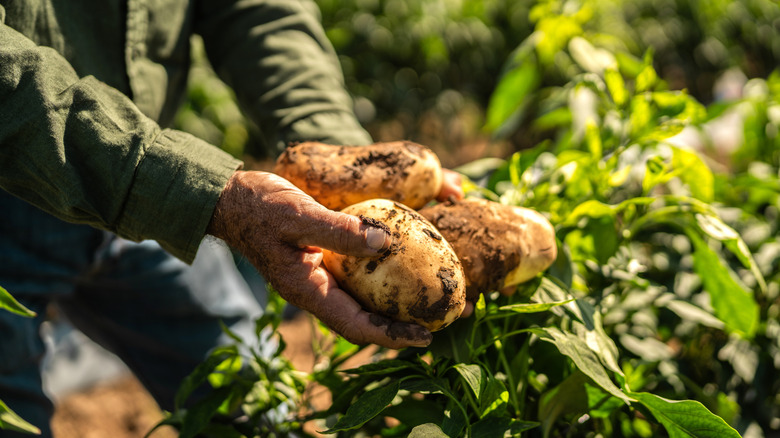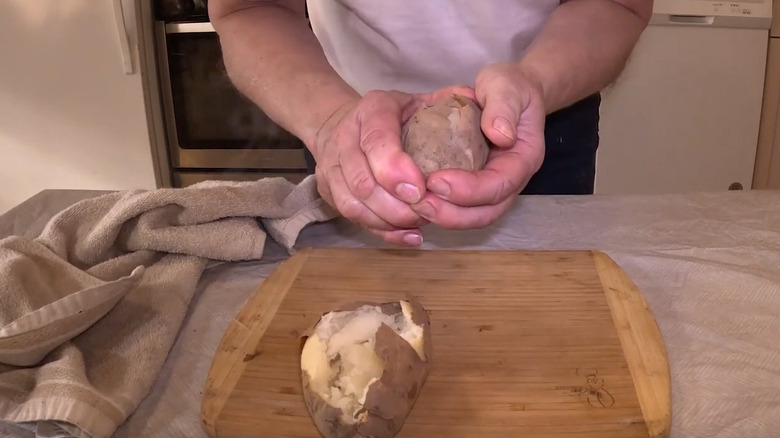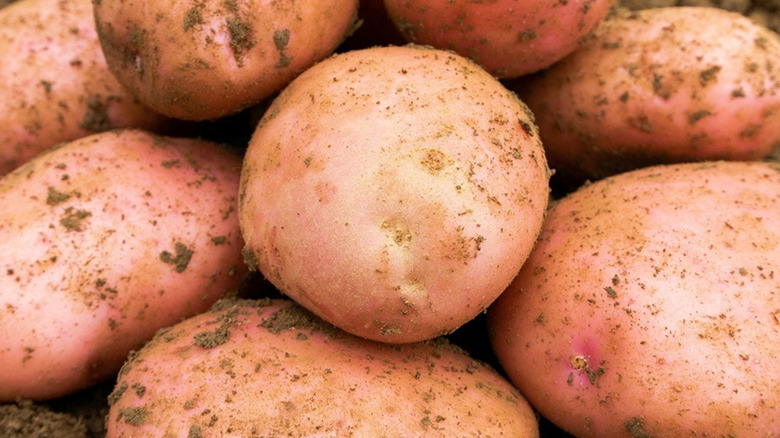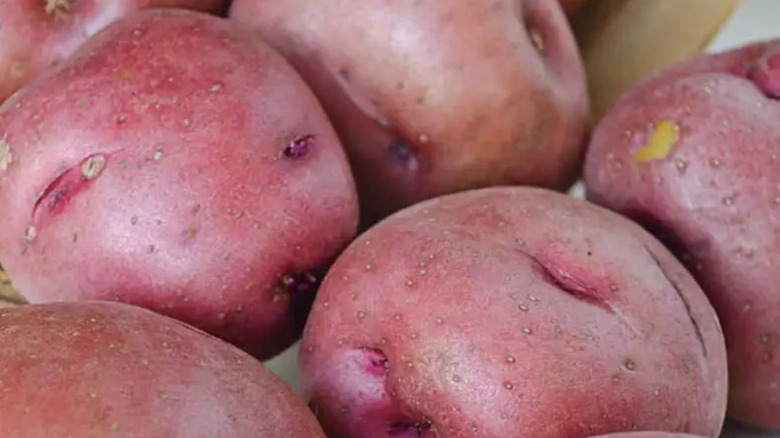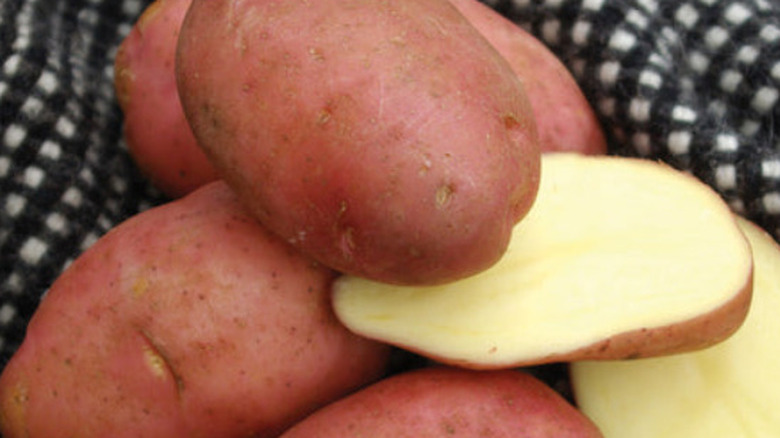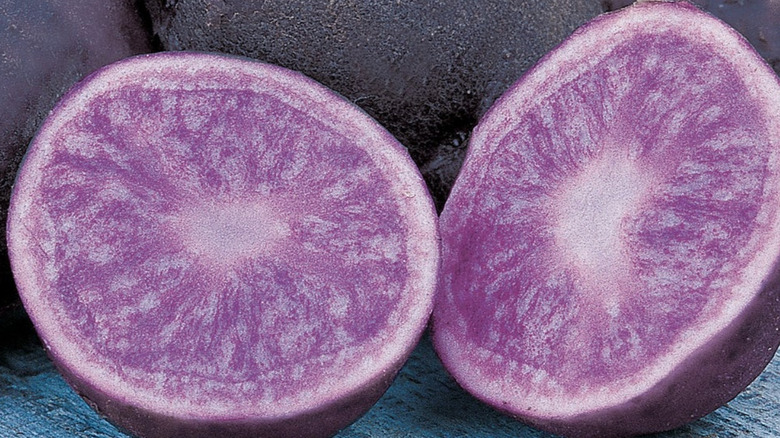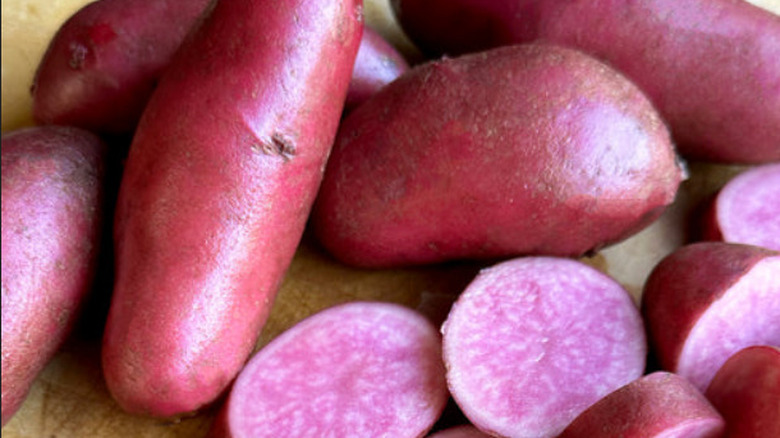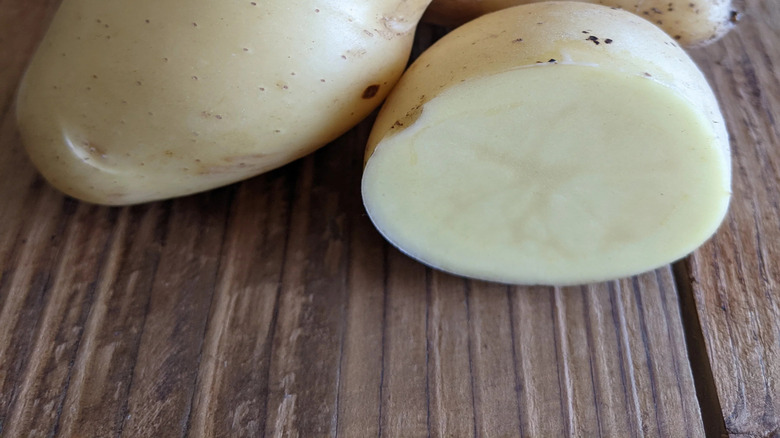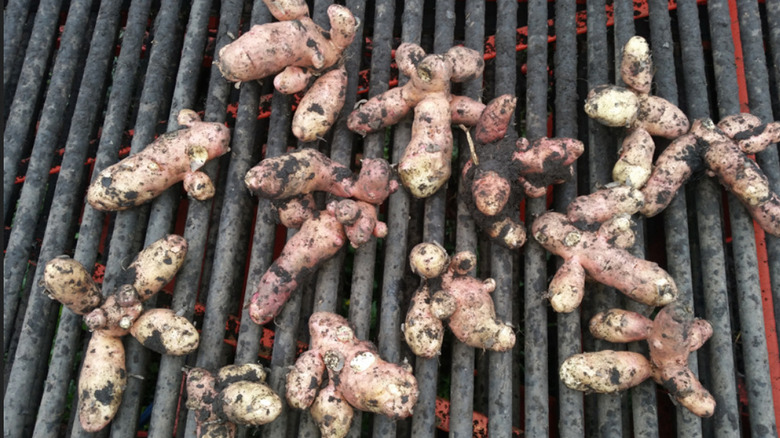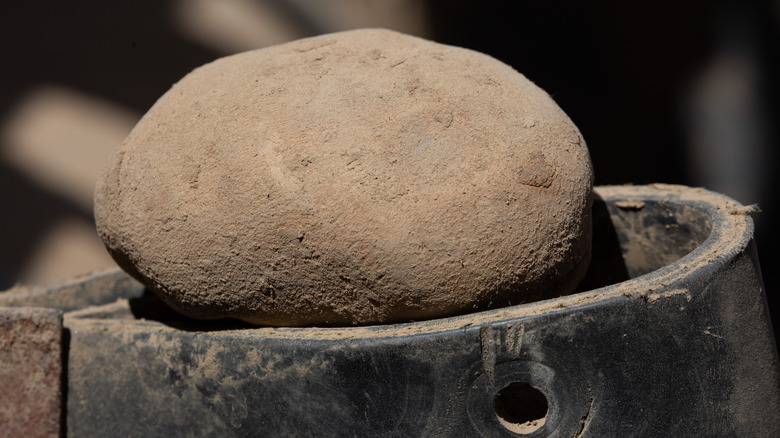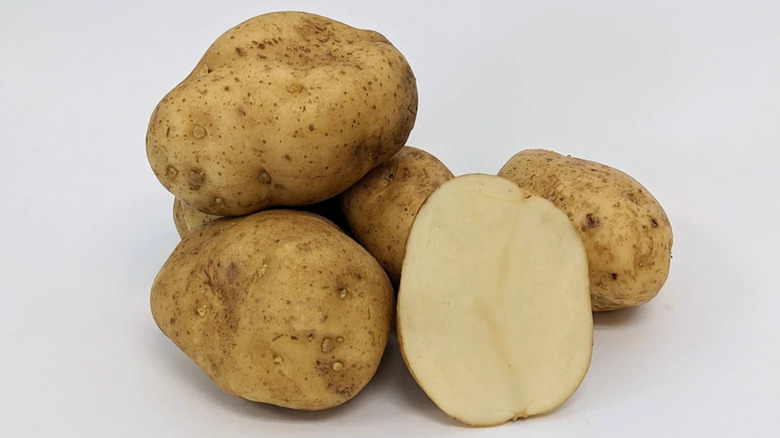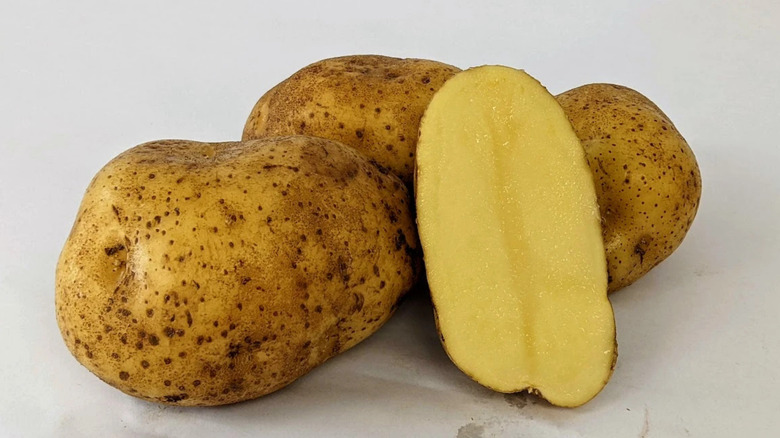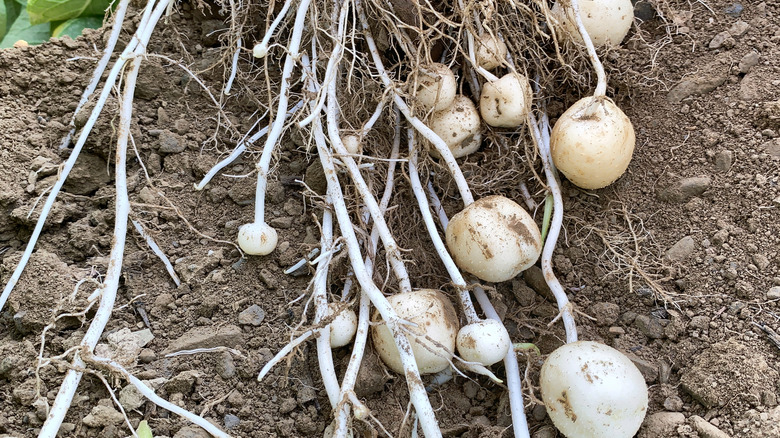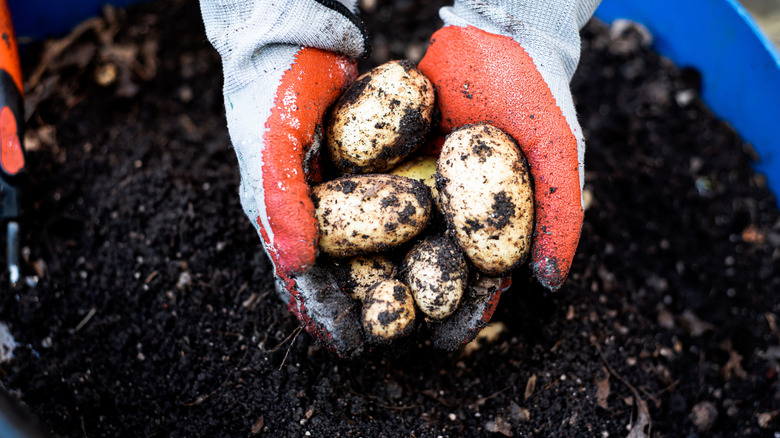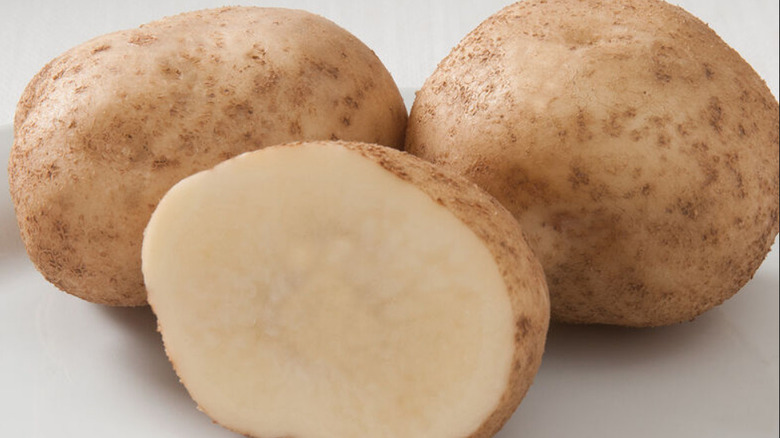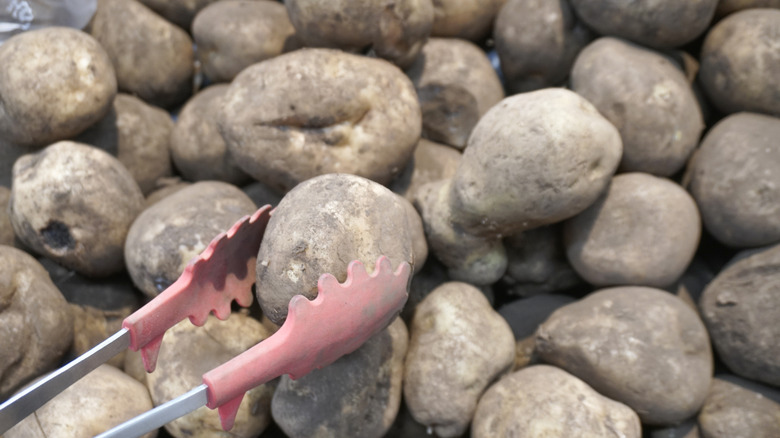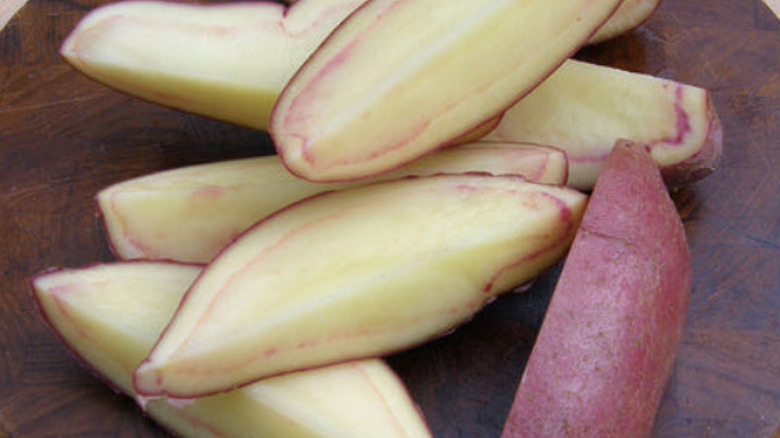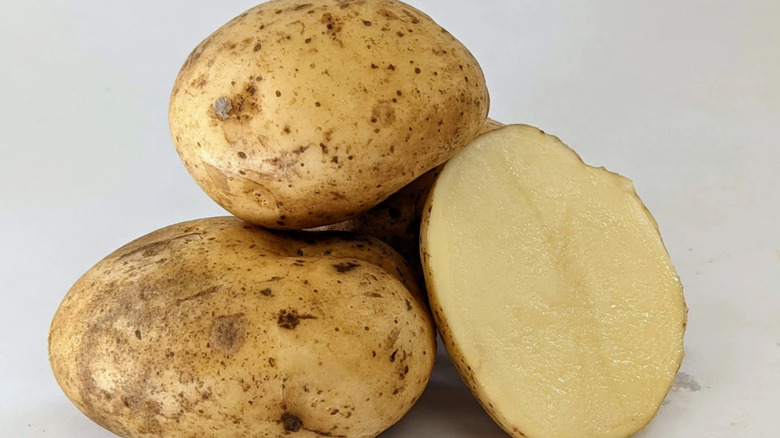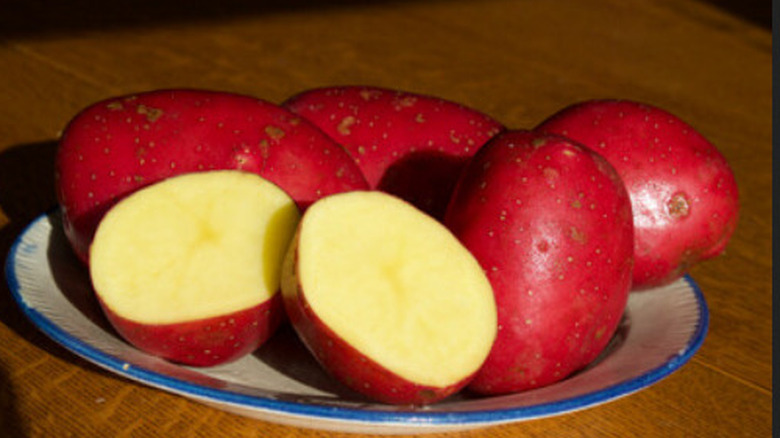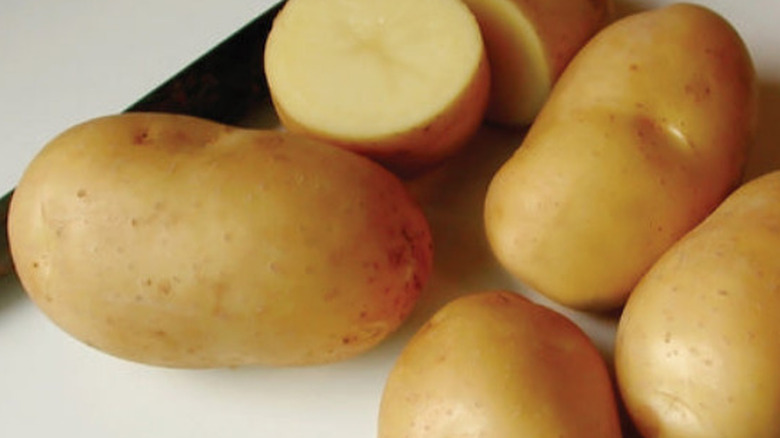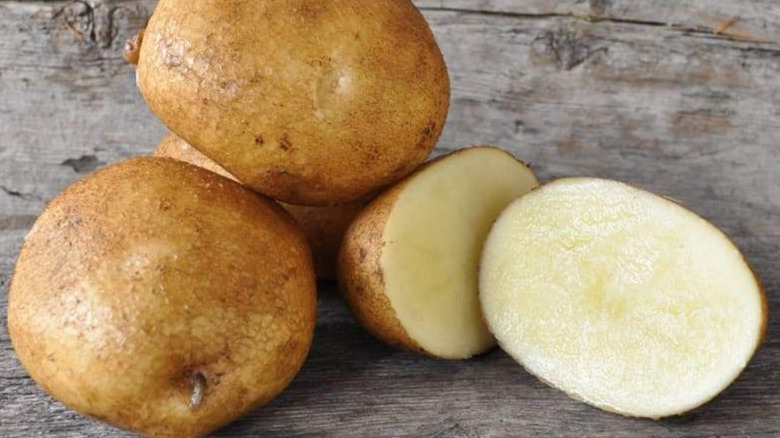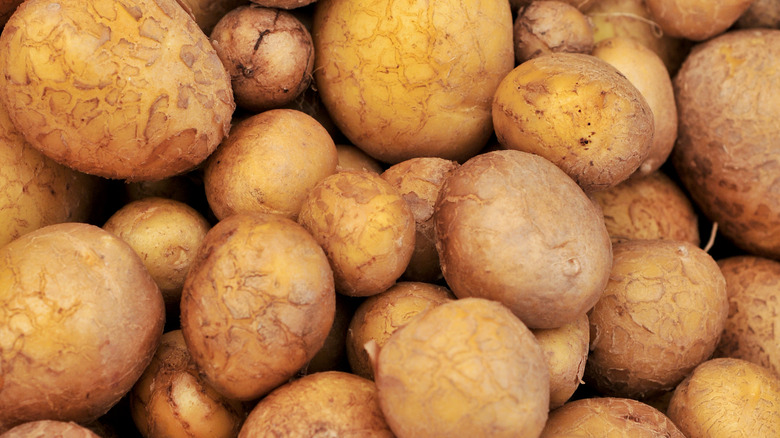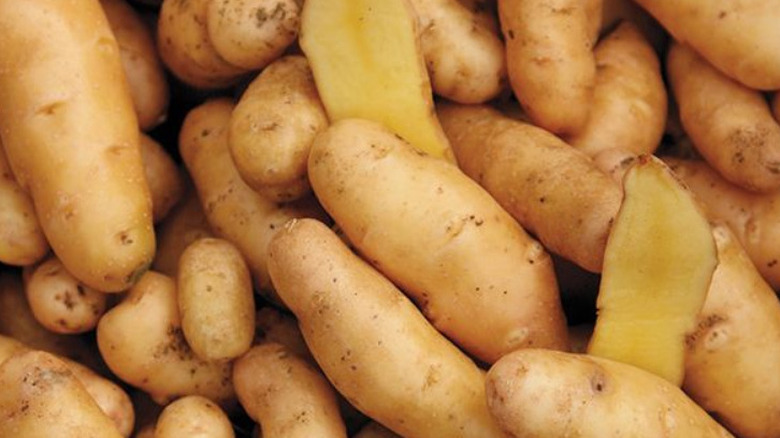Potato Varieties That Thrive When Planted And Grown In The Fall
Most potatoes are best grown in the fall or spring, as the temperature is neither too hot nor too cold. However, if you want the best chances of your potatoes thriving when planted in the fall, look specifically for late-season varieties. You can also grow them in containers for the best chance of a strong crop. Potatoes like 'Green Mountain', 'Bintje', 'Snowden', and 'Baltic Rose' are just some of the examples of amazing potato varieties that could work well for fall planting.
All potatoes are part of the Solanum tuberosum species, which includes different varieties. You'll find that most are lumped into seven major categories: russet, red, white, yellow, blue or purple, fingerling, and petite. Sometimes, they may also be considered an heirloom species, which is a variety that has not been changed or manipulated for at least 100 years.
It's worth mentioning that these potato varieties might not work for all zones. The tubers are native to tropical mountains. Though they don't like hot weather, they also dislike freezing temperatures. Generally, they prefer the average outdoor growing temperature to be somewhere between 45 and 74 degrees Fahrenheit, or soil not much cooler than 60 degrees. Planting at the wrong temperature is one of the common mistakes that are limiting your potato harvest, so it's important to get it right. If you get cold falls and winters where you live, you may have to focus on spring planting or grow them inside a greenhouse.
Butte
'Butte' potatoes are a form of russet, and are brown and starchy, making them perfect for baking, mashing, or frying. They produce a pretty classic potato flavor and appearance, so there's nothing unexpected, but they do have a high vitamin C content compared to similar varieties. Depending on when you plant them in the fall, they should be ready to pull up by the end of February. However, make sure you know the easy tips for when it's time to harvest new potatoes so you can grab them as soon as they are ready.
Sarpo Mira
'Sarpo Mira' potatoes are highly resistant to blight, which can be a big problem for people planting tubers. They are high-starch red potatoes with deep roots perfect for baking, boiling, frying, and mashing. These are considered maincrops, which take over 100 days to grow, and are usually planted in spring for a big harvest. However, you can get a fair amount of potatoes if you plant them in fall, so long as you have a few months until a hard frost hits. Or, if you want a big harvest, grow them in a greenhouse.
Red Pontiac
'Red Pontiacs' are a variety of red potatoes that are easy to grow. They are the perfect choice for a delicious mashed side dish. It produces a fair amount of potatoes per plant and stores well, making it a great option for the average person who is looking for a crop to get them through most of the year. These are also somewhat resistant to some pests and viruses, though it doesn't hurt to choose a companion herb that can protect your potato plants from pests to put your mind at ease.
Desiree
Probably the most popular red potato in all of Europe, 'Desiree' has the classic red skin and yellow flesh you'd expect from this variety. They are creamy and great in any cooking dish, though they aren't great for potato salad. As for growing, they are considered to be pretty reliable, and they have a fairly short season, which makes them one of the more ideal potatoes to grow in the fall. However, you can easily leave them in the soil longer and get larger tubers if the weather cooperates.
All Blue
'All Blue' is a classic potato variety that has been around for over a century. It's a blue or purple tuber that can be small unless allowed to grow to full maturity, which may require a longer season. However, while the potatoes might be small, they can be pretty delicious, making excellent chips or mash, though it doesn't always look the prettiest in this form. Despite its unusual appearance, it grows like normal, so you can follow the standard tips to start your own seed potatoes if you find some in the store.
Amarosa
'Amarosa' is a fingerling potato with pink on both the skin and the flesh. It keeps the color pretty well when cooked. These potatoes have a somewhat unique flavor often described as creamy and nutty. They hold up well to cooking and make excellent additions to potato salads or stews and can be made into beautiful chips. This is a relatively new variety, first released in 2010, and while usually grown in the spring, it can be good to plant in fall. Though it might take some testing to see when it will do best in your garden.
Bintje
'Bintje' potatoes are yellow, known for their ability to grow pretty much anywhere and their flexibility in use. Many potato lovers describe them as having a great balance between being starchy and waxy, which makes the end result creamy and fluffy. They have a slightly longer growing season, but can potentially be ready to give you delicious tubers as early as fall if you don't have a lot of frost. They last a long time and make for a great storage potato, but they are a bit susceptible to common diseases and pests.
Pink Fir Apple
Despite their names, these are not apples, but a variety of fingerling potatoes. Their skin is pink, and their flesh is yellow. They are not the most attractive, with an uneven, knobby texture, but they do great in almost any form of cooking or use. They are a late-season tuber, which makes them excellent to plant in the fall. Additionally, the 'Pink Fir Apple' is a potato variety every gardener should know about, thanks to their ability to produce a high yield and delicious taste. They are also resistant to diseases and have a short growing season.
Russet Burbank
While this name may not sound familiar, it is probably a variety you know extremely well. 'Russet Burbank' is the famous Idaho potato, used to make French fries across the country. Despite their popularity, they are not the best for all uses, making them primarily ideal for fries and baked potatoes; otherwise, they are described as rather dry and mealy. They do take a longer time to grow, so they may be best in a greenhouse or somewhere with mild winters. However, this cultivar produces enough potatoes to make the wait worth it.
Green Mountain
Green mountain is a late-season potato with white flesh. This one doesn't easily fall into the seven main categories and is usually described as an heirloom with smooth skin. When baked, mashed, or fried, it has an earthy flavor and a fluffy texture. While this is a delicious potato, it is incredibly susceptible to pests and disease, which can make it a bit of a headache for home gardeners. However, planting it in the fall season may be the better option, as at least most of the insects are starting to hide away for the year.
Lehigh
'Lehigh' is a yellow potato. The plant tends to produce a lot of tubers, all of which grow fairly sizable. It's best used for soups and stews, but makes for a decent fried option as well. It maintains its shape when cooked and is considered a dry and waxy variety. It grows best in the northern part of the United States and is a mid to late season plant. However, it also does well in much of the country. It is resistant to a few common potato problems, which makes it fairly easy to grow.
Snowden
This russet potato was bred for a very specific purpose. 'Snowden' is primarily used to make bagged chips, though it also does fine for boiling and baking. However, it is susceptible to blight and scab, so it's best to keep a careful eye on this plant to ensure it grows properly. If cared for properly, you should get quite a few tubers from every plant, as it's known to be a high-yield variety. Because of how many potatoes it produces, it can take a while to be ready to harvest, anywhere between 82 and 119 days.
Kennebec
'Kennebec' potatoes take somewhere between 80 and 100 days from seed potato to harvest. They are considered an all-purpose and high-yielding variety. They were originally bred for frying but turned out to have a great flavor and texture that made them ideal for many forms of cooking. Their high starch and sugar content gives them a faintly sweet taste. However, though they can stay good for a few months, they do have a shorter storage life than some other varieties, which means they're not always an ideal choice for home gardeners who might eat them slowly over time.
Elba
'Elba' is a late season white potato, perfect for planting in the fall. They produce an abundance of tubers, and handle both wet and dry years well, though they can form a hollow core when they are grown in too wet conditions. 'Elba' potatoes are often described as waxy but firm, and are great for baking, boiling, roasting, as a salad, or mashed with a pleasant and delicious flavor. Some people consider them to be a better alternative to 'Kennebec' when it comes to cooking and growing, as they are resistant to most common diseases.
Irish Cobbler
Irish cobbler is another unique heirloom vegetable that gardeners should want to grow and has been around since the 1870s. Each plant produces a high yield of tubers. They are also quick to grow, only needing 65 to 80 days to reach full maturity. They are described as having a dry yet creamy taste, perfect for boiling, and have white skin and flesh. It's a reliable variety, easy for beginners and those growing in the fall because of how simple it is to grow and its vigor. They also store well.
French Fingerling
French fingerlings are heirloom fingerlings – long and narrow potatoes — with a distinct red and smooth skin and yellow flesh. They are a little larger than other potatoes in this category, and have additional similar characteristics, including a waxy texture. Many people describe it as sweet and faintly nutty. They are best used when roasted or boiled whole. They are also fairly firm, which makes them a great choice for salads and casseroles. Since fingerling potatoes should be harvested early in the season, they work well when planted in fall.
Katahdin
'Katahdin' is another late season variety exceptionally suited for growing in Maine, and is actually named after the tallest mountain in the state. They are considered drought-resistant and produce a large number of tubers. The potatoes are roundish with smooth skin and white flesh and they work well boiled, baked, or used in potato salad. 'Katahdin' is fairly susceptible to a few diseases. Despite being late season, they do have a long time to maturity, about 105 to 135 days, so it may be worth planting these in a greenhouse if you get early winters.
Baltic Rose
As its name might suggest, 'Baltic Rose' is a red potato with yellow insides. It's a nutty and creamy variety and has skin that's easy to peel off for roasting, frying, or making potato salad. To make this potato even easier to care for, it's also fairly disease-resistant and stores well until you're ready to use it. If you are going to experience freezing temperatures, these potatoes do great when picked early and boiled. You can also follow some helpful tips to ensure a bountiful potato harvest, including mounding the soil.
Carola
'Carola' is a golden potato originating from Germany. Their skin is usually smooth but can have freckles in brown or tan that makes a spud look dirty even when they are not. It is considered a medium to late season potato variety that can take up to 110 days to reach full maturity. They are a delicious tuber and can be used in many forms, including grilled, mashed, fried, and roasted. Their starch content is low, and they are sweet, nutty, and fluffy. They also maintain their quality even when stored.
Keuka Gold
'Keuka Gold' is another mid to late season potato with yellow flesh. It was released to the public in 2004 at Cornell University as direct competition to Yukon gold potatoes. It's designed to be able to handle variable temperatures and bursts of rain while still growing strong. It's also resistant to many different diseases and can handle a variety of soil types. It works for most cooked forms of potato. However, if you truly want to see these potatoes at their best, boil them. Expect 'Keuka Gold' to take roughly 95 days to reach maturity.
German Butterball
German butterballs are another heirloom variety. They are so well-rounded and durable that they were the first-place winner of Organic Gardening magazine's Taste Off. They grow best in the mid to late season, and take between 100 and 125 days to reach full maturity. Many growers of these potatoes say they work for pretty much any form of cooking, but they are particularly great for making hashbrowns and baked potatoes. The texture is described as flaky but not dry, and it is firm enough to retain its shape.
Russian Banana Fingerling
Russian banana fingerling potatoes are heirloom fingerlings from Northeastern Europe. This variety is known for its thin skins, and creamy but firm flesh. Their flavor is described as similar to chestnuts with a waxy texture, and they hold up when cooked, which makes them ideal for salads. They can also handle a little bit of drought and produce quite a few potatoes per plant. The only downside is that they can take up to 125 days to grow, which means it may not be ideal for fall planting in all USDA zones.
